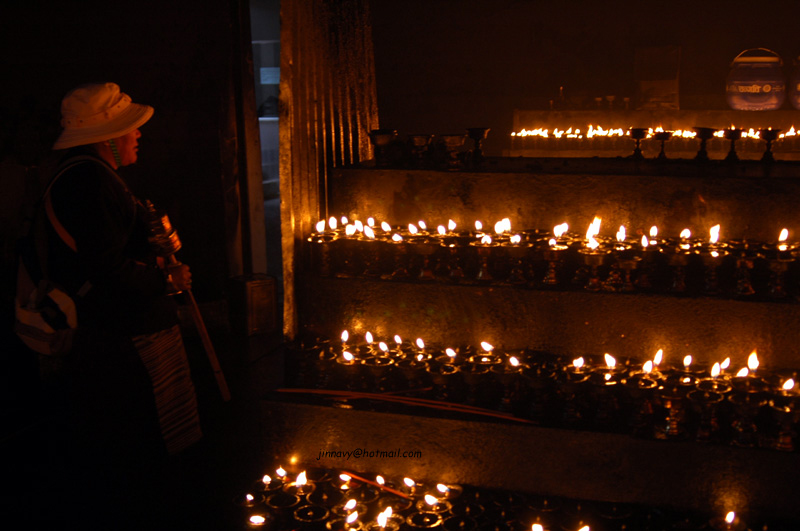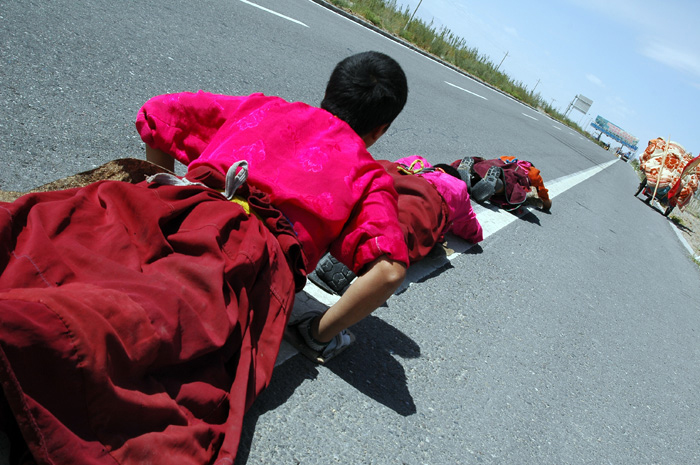
Colourful prayer flags fluttering atop piles of mani stones[1]; monks chanting mantras in a low and haunting voice; the thick scent of incense wafting on the breeze; these are the sights, sounds, and smells we’ve come to associate with Tibet. As a deeply spiritual ethnic group, Tibetans practice their religion with a piety and fervour that has captured the attention of people throughout the globe. Their complete and utter dedication to their faith is arguably their defining feature. While nowadays the majority of Tibetans adhere to Tibetan Buddhism, their spiritual love affair began with an indigenous religion known as Bön. Bön is a shamanistic[2] and animistic[3] faith that is thought to have been the first religion in Tibet. It revolves around a belief in numerous deities, demons, and ancestral spirits that can be contacted by special priests, known as shamans.
Buddhism did not truly take root in the country until the 7th century, during the reign of the Tibetan king Songtsän Gampo. His two wives, Princess Bhrikuti of the Nepalese Licchavi Kingdom (c. 400–750 AD) and Princess Wencheng of the Han Chinese Tang Dynasty (618-907), were staunch believers in Buddhism and eventually persuaded him to share their faith. When the Indian Buddhist master Padmasambhāva visited Tibet during the 8th century at the behest of King Trisong Detsän, the religion’s popularity was firmly cemented. As time went on, Bön began to incorporate features of Buddhism, and so too did Buddhism in Tibet start to adopt concepts from Bön.
The arrival of the Buddhist master Atīśa in 1042 triggered a reform movement in Tibet and, within a century, many major sects of Tibetan Buddhism had been established. By the 17th century, the Gelugpa or Yellow Hat sect had risen to become the dominant spiritual and political entity in Tibet; a situation that would remain unchanged until 1959. Elaborate complexes such as the Potala Palace, the Jokhang Temple, and the Ganden Monastery all stand as grand monoliths to the religion’s historical importance. While a minority of adherents continue to practice Bön, the sheer plethora of monasteries and temples dedicated to Tibetan Buddhism act as a testament to its enduring supremacy.

Tibetan Buddhism was initially based on the Vajrayana or Tantric sect of Buddhism, but has since also adopted features from the Madhyamaka and Yogachara schools of philosophy. It is the religion’s unique features, however, that have helped it to stand out on the international stage. In particular, it is renowned for its system of tulku or “reincarnated Buddhist masters”, the most well-known of which are the Dalai Lama and the Panchen Lama[4]. Each time an old tulku dies, a panel of senior monks is charged with locating the young person who harbours their re-incarnated soul. The process for finding these reincarnations has gradually changed over the years, but is nevertheless a fascinating and mysterious ritual that sets Tibetan Buddhism apart from its peers.
Nowadays, the most common Buddhist practice seen throughout Tibet is the spinning of prayer wheels containing Buddhist scriptures. They come in a variety of types and sizes, with small, handheld ones being the most popular. Prayer wheels are spun in lieu of orally chanting mantras and are particularly helpful for the illiterate, who might otherwise be unable to accurately recite Buddhist scripture. The wheels are traditionally turned clockwise, although practitioners of Bön spin them counter-clockwise.

Another act of religious importance is the practice of pilgrimage and prostration. On the roads leading to Lhasa, you may catch a glimpse of Buddhists prostrating on their way to the capital. Depending on where they’ve come from, these pilgrimages can take weeks, months, or even years! Every three steps, the pilgrim is expected to prostrate themselves as part of an intricate ritual. Firstly, they must stand upright and chant what is known as the “Om Mani Padme Hum” mantra. They then put their palms together, raise their hands over their head, and take a step forward.
Lowering the hands in front of their face, they take another step forward and prepare to prostrate. To do this, they must lower their hands down to their chest, separate them, reach out with their palms facing downwards, and kneel onto the ground. The final step is to prostrate with the forehead slightly touching the ground. The time-consuming nature of this ritual means that many people simply choose to do it while circumambulating a Buddhist monastery in a clockwise direction, rather than making the pilgrimage all the way to Lhasa. In much the same way, Tibetan people will walk in a clockwise direction around pagodas, stupas[5], or piles of mani stones while chanting mantras as a mark of respect. As we head into an era of increasing modernisation, we can only hope that these rich spiritual traditions and soothing rituals will not be lost.
Notes:
[1] A mani stone is a stone plate, rock, or pebble that has been inscribed with the six-syllabled Buddhist “Om Mani Padme Hum” mantra. They are usually placed by roadsides or rivers either alone, as part of a large mound, or arranged into a wall. According to Tibetan Buddhism, they serve as a form of prayer or religious offering.
[2] Shamanism: The practice of attempting to reach altered states of consciousness in order to communicate with the spirit world and channel energy from it into the real world. This can only be done by specialist practitioners known as shaman.
[3] Animism: The belief that all non-human entities, including animals, plants, and even inanimate objects, possess a spiritual essence or soul.
[4] The Panchen Lama: The highest ranking lama after the Dalai Lama according to Tibetan Buddhism.
[5] Stupa: A hemispherical structure with a small interior designed for storing Buddhist relics and for private meditation.